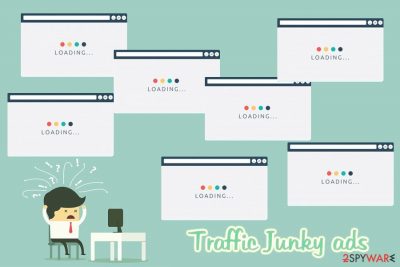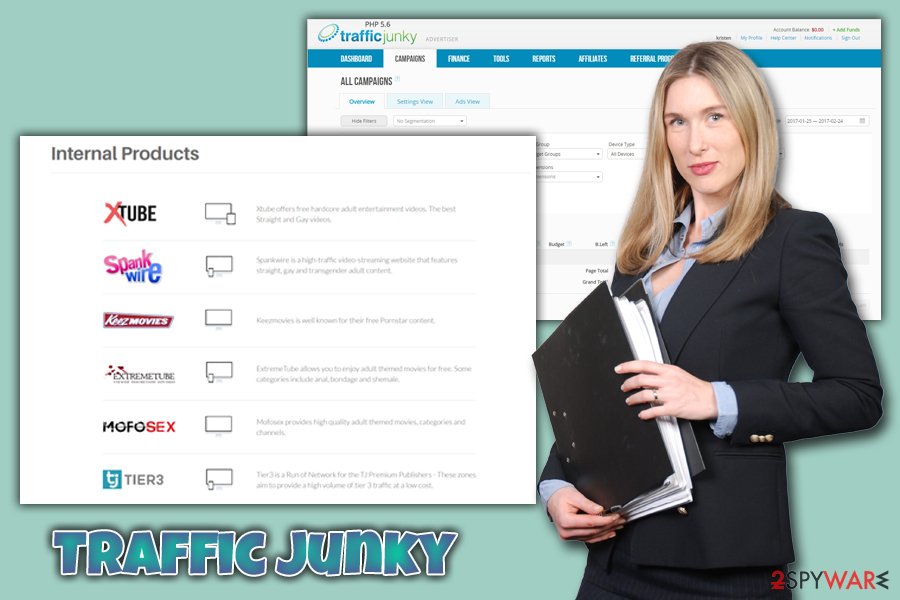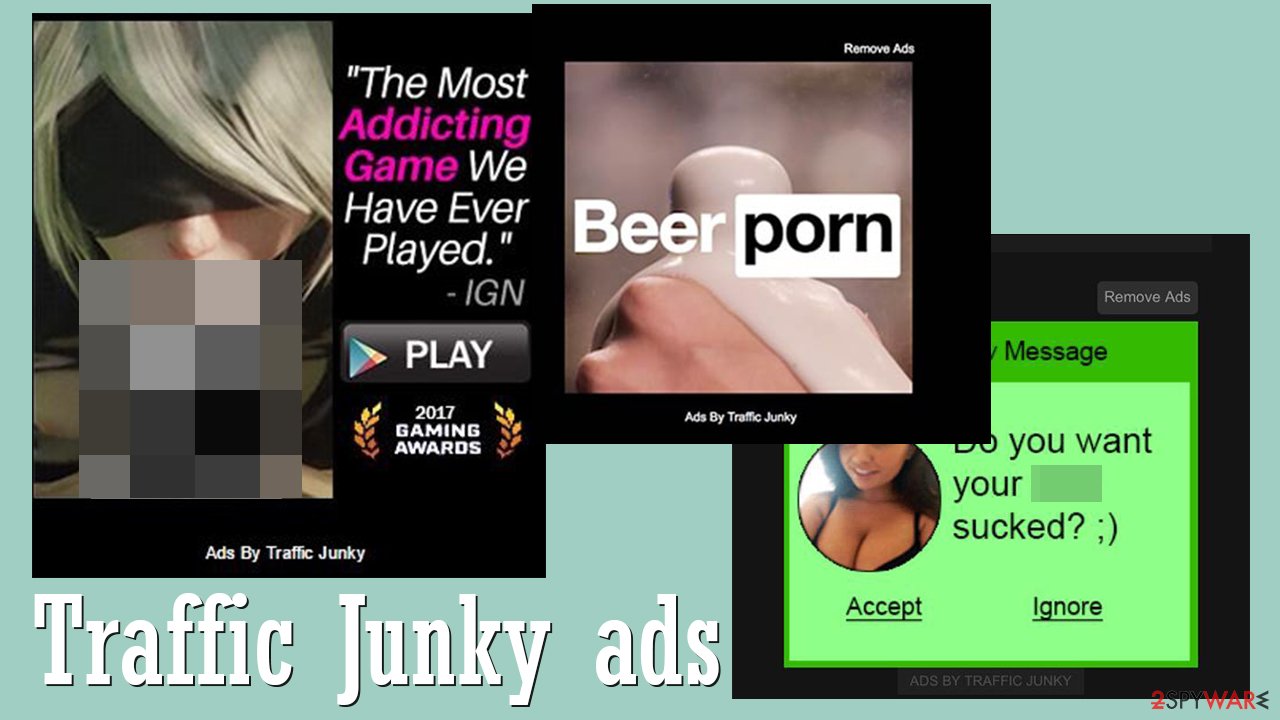Traffic Junky (Tutorial) - May 2021 update
Traffic Junky Removal Guide
What is Traffic Junky?
Traffic Junky is a legitimate advertisement service that might be abused by adware apps

Ads by Traffic Junky is an online marketing platform that, according to its creators, “helps advertisers and publishers to achieve their marketing goals.” However, website authors who did try using this service were highly disappointed, as promised traffic did not meet the expectations.
Additionally, users mentioned that their websites were plagued with malicious advertisement banners that lead to truly insecure domains. Regular internet users complained about intrusive ads by TrafficJunky on Google Chrome, Internet Explorer, Mozilla Firefox, Safari, and other browsers. While some of them might direct users to harmless sites, others might show inappropriate, X-rated content or expose visitors to scams, resulting in monetary losses, installation of malware/potentially unwanted programs, or personal information disclosure to cybercriminals.
The annoying redirects are typically initiated by adware[1] – a potentially unwanted program that disturbs users' web time by displaying pop-ups, banners, coupons, pop-unders, video, and audio ads, etc. Because of such invasive behavior, users even refer to it as “Traffic Junky virus.”
| Summary | |
| Name | Ads by traffic junky |
| Type | Adware, advertising network |
| Distribution | Software bundling, suspicious websites |
| Browsers | Google Chrome, Internet Explorer, Mozilla Firefox, Safari, Opera, etc. |
| Symptoms | Advertisement banners, pop-ups, pop-unders and other intrusive ads disturb browsing activities |
| Main dangers | Malware infection, sensitive data leak |
| Removal | Use our ads by traffic junky elimination guide below or opt for automatic PUP elimination using security software |
| Optimization | To make sure all the changes made by adware are reverted, use FortectIntego as a PC repair tool |
Potentially unwanted programs often infiltrate users' machines when they are prompted to click questionable links or via software bundling. The latter is most prominent, and users are still unaware of this deceptive marketing technique used by adware developers. To avoid adware infection, make sure you check the installation process of free software thoroughly.
Ads mostly appear as banners and are especially prevalent on X-rated sites such as PornHub (pop-ups, pop-unders, in-text links, full-page ads, etc., may also sometimes show up). If you are not willing to expose your computer to suspicious or even unsafe websites, you should avoid clicking on any “Ads by Traffic Junky” prompts. Considering many people are using their phones, accidental taps might be possible due to the shifting/loading page, however.
While the related ads might be simply embedded within websites, persistent ad activity on all visited websites might easily hint at adware or malware infection. Users reported that the service delivers malicious ads to websites, which might infect visitors' PCs with malware. Website developers were appalled by the fact that such activity is propagated and did not want to be associated with delivery systems like that.[2]
Additionally, security experts[3] warn that adware might be involved in excessive information gathering. The PUP might collect the following data:
- IP address
- Geolocation
- Websites visited
- Links clicked
- Bookmarks
- Cookies, etc.
To gather this info, advertisers typically employ tracking technologies like JavaScript and beacons. Therefore, if you value your privacy, remove ads from your machine by eliminating adware associated with it. Because potentially unwanted applications might change various browser and system settings, we recommend scanning your computer with FortectIntego.

Note: if you are seeing ads everywhere and are suddenly redirected to suspicious sites, it might be that something more sinister is going on in the background. We strongly recommend performing a full system scan with SpyHunter 5Combo Cleaner or Malwarebytes anti-virus software to ensure that malicious programs are running in the background without your permission.
Ways to avoid the infiltration of suspicious applications
Since potentially unwanted apps are used only for monetization purposes, it's not surprising that the authors employ suspicious methods to infiltrate computers without being noticed. The adware responsible for displaying suspicious advertisements may land on your computer right after installing another freeware. As we already mentioned above, such a distribution method is called software bundling and is a primary delivery method of suspicious programs.
When third-party apps, such as various browser add-ons, plug-ins, toolbars, and extensions spread bundled with freeware and shareware, they need the user's authorization to be installed. Therefore, if a potentially unwanted program infiltrated your machine, it's clear that you have installed a freeware app incorrectly.
Keep in mind that the internet is full of bundled software, so you need to be alert at all times. Thus, read some reviews about the app you are planning to install, and then make sure that you select the Advanced or Custom installation option (instead of Quick or Recommended) and carefully monitor the entire installation process.
Finally, you have to remove tick marks next to optional installs, such as toolbars, add-ons, system optimization tools, media players, and similar. Software bundling rarely offers useful apps as PUP authors often want to cash-in quickly without spending many investments into a proper advertisement. By the way, avoid downloading third-party installers, such as Softonic, InstallRex, Soft32, Cnet, and so on because they frequently promote potentially unwanted programs.
You can remove intrusive ads either manually or automatically
If you seek to remove ads by Traffic Junky, you either run a full system scan with a reputable anti-spyware software or follow the manual removal guide. Beware that manual elimination requires a lot of attention to detail and some basic computer knowledge. Additionally, this method will not protect you from PUP infiltration in the future.

For quick removal, we suggest using anti-virus software. This method is also very easy to execute, and even less computer-savvy individuals can use it. All they have to do is download a security application and then follow on-screen instructions to perform a full system scan.
Keep in mind that some ads might be simply embedded within the website that you visit, and the only way to get rid of them is to either leave the page or employ an ad-blocking extension. While the latter is a great choice, some websites do not allow visits when such tools are enabled, so some website components might be completely broken upon entry. Besides, it also prevents content creators from monetizing their content. On the other hand, ad-blockers are great tools to avoid overly-intrusive and malicious ads that can be encountered virtually anywhere.
You may remove virus damage with a help of FortectIntego. SpyHunter 5Combo Cleaner and Malwarebytes are recommended to detect potentially unwanted programs and viruses with all their files and registry entries that are related to them.
Getting rid of Traffic Junky. Follow these steps
Uninstall from Windows
To remove unwanted programs from Windows operating systems, follow these instructions:
Instructions for Windows 10/8 machines:
- Enter Control Panel into Windows search box and hit Enter or click on the search result.
- Under Programs, select Uninstall a program.

- From the list, find the entry of the suspicious program.
- Right-click on the application and select Uninstall.
- If User Account Control shows up, click Yes.
- Wait till uninstallation process is complete and click OK.

If you are Windows 7/XP user, proceed with the following instructions:
- Click on Windows Start > Control Panel located on the right pane (if you are Windows XP user, click on Add/Remove Programs).
- In Control Panel, select Programs > Uninstall a program.

- Pick the unwanted application by clicking on it once.
- At the top, click Uninstall/Change.
- In the confirmation prompt, pick Yes.
- Click OK once the removal process is finished.
Remove from Microsoft Edge
Delete unwanted extensions from MS Edge:
- Select Menu (three horizontal dots at the top-right of the browser window) and pick Extensions.
- From the list, pick the extension and click on the Gear icon.
- Click on Uninstall at the bottom.

Clear cookies and other browser data:
- Click on the Menu (three horizontal dots at the top-right of the browser window) and select Privacy & security.
- Under Clear browsing data, pick Choose what to clear.
- Select everything (apart from passwords, although you might want to include Media licenses as well, if applicable) and click on Clear.

Restore new tab and homepage settings:
- Click the menu icon and choose Settings.
- Then find On startup section.
- Click Disable if you found any suspicious domain.
Reset MS Edge if the above steps did not work:
- Press on Ctrl + Shift + Esc to open Task Manager.
- Click on More details arrow at the bottom of the window.
- Select Details tab.
- Now scroll down and locate every entry with Microsoft Edge name in it. Right-click on each of them and select End Task to stop MS Edge from running.

If this solution failed to help you, you need to use an advanced Edge reset method. Note that you need to backup your data before proceeding.
- Find the following folder on your computer: C:\\Users\\%username%\\AppData\\Local\\Packages\\Microsoft.MicrosoftEdge_8wekyb3d8bbwe.
- Press Ctrl + A on your keyboard to select all folders.
- Right-click on them and pick Delete

- Now right-click on the Start button and pick Windows PowerShell (Admin).
- When the new window opens, copy and paste the following command, and then press Enter:
Get-AppXPackage -AllUsers -Name Microsoft.MicrosoftEdge | Foreach {Add-AppxPackage -DisableDevelopmentMode -Register “$($_.InstallLocation)\\AppXManifest.xml” -Verbose

Instructions for Chromium-based Edge
Delete extensions from MS Edge (Chromium):
- Open Edge and click select Settings > Extensions.
- Delete unwanted extensions by clicking Remove.

Clear cache and site data:
- Click on Menu and go to Settings.
- Select Privacy, search and services.
- Under Clear browsing data, pick Choose what to clear.
- Under Time range, pick All time.
- Select Clear now.

Reset Chromium-based MS Edge:
- Click on Menu and select Settings.
- On the left side, pick Reset settings.
- Select Restore settings to their default values.
- Confirm with Reset.

Remove from Mozilla Firefox (FF)
After PUP elimination, refresh Firefox using this guide:
Remove dangerous extensions:
- Open Mozilla Firefox browser and click on the Menu (three horizontal lines at the top-right of the window).
- Select Add-ons.
- In here, select unwanted plugin and click Remove.

Reset the homepage:
- Click three horizontal lines at the top right corner to open the menu.
- Choose Options.
- Under Home options, enter your preferred site that will open every time you newly open the Mozilla Firefox.
Clear cookies and site data:
- Click Menu and pick Settings.
- Go to Privacy & Security section.
- Scroll down to locate Cookies and Site Data.
- Click on Clear Data…
- Select Cookies and Site Data, as well as Cached Web Content and press Clear.

Reset Mozilla Firefox
If clearing the browser as explained above did not help, reset Mozilla Firefox:
- Open Mozilla Firefox browser and click the Menu.
- Go to Help and then choose Troubleshooting Information.

- Under Give Firefox a tune up section, click on Refresh Firefox…
- Once the pop-up shows up, confirm the action by pressing on Refresh Firefox.

Remove from Google Chrome
Delete malicious extensions from Google Chrome:
- Open Google Chrome, click on the Menu (three vertical dots at the top-right corner) and select More tools > Extensions.
- In the newly opened window, you will see all the installed extensions. Uninstall all the suspicious plugins that might be related to the unwanted program by clicking Remove.

Clear cache and web data from Chrome:
- Click on Menu and pick Settings.
- Under Privacy and security, select Clear browsing data.
- Select Browsing history, Cookies and other site data, as well as Cached images and files.
- Click Clear data.

Change your homepage:
- Click menu and choose Settings.
- Look for a suspicious site in the On startup section.
- Click on Open a specific or set of pages and click on three dots to find the Remove option.
Reset Google Chrome:
If the previous methods did not help you, reset Google Chrome to eliminate all the unwanted components:
- Click on Menu and select Settings.
- In the Settings, scroll down and click Advanced.
- Scroll down and locate Reset and clean up section.
- Now click Restore settings to their original defaults.
- Confirm with Reset settings.

Delete from Safari
Remove unwanted extensions from Safari:
- Click Safari > Preferences…
- In the new window, pick Extensions.
- Select the unwanted extension and select Uninstall.

Clear cookies and other website data from Safari:
- Click Safari > Clear History…
- From the drop-down menu under Clear, pick all history.
- Confirm with Clear History.

Reset Safari if the above-mentioned steps did not help you:
- Click Safari > Preferences…
- Go to Advanced tab.
- Tick the Show Develop menu in menu bar.
- From the menu bar, click Develop, and then select Empty Caches.

After uninstalling this potentially unwanted program (PUP) and fixing each of your web browsers, we recommend you to scan your PC system with a reputable anti-spyware. This will help you to get rid of Traffic Junky registry traces and will also identify related parasites or possible malware infections on your computer. For that you can use our top-rated malware remover: FortectIntego, SpyHunter 5Combo Cleaner or Malwarebytes.
How to prevent from getting adware
Choose a proper web browser and improve your safety with a VPN tool
Online spying has got momentum in recent years and people are getting more and more interested in how to protect their privacy online. One of the basic means to add a layer of security – choose the most private and secure web browser. Although web browsers can't grant full privacy protection and security, some of them are much better at sandboxing, HTTPS upgrading, active content blocking, tracking blocking, phishing protection, and similar privacy-oriented features. However, if you want true anonymity, we suggest you employ a powerful Private Internet Access VPN – it can encrypt all the traffic that comes and goes out of your computer, preventing tracking completely.
Lost your files? Use data recovery software
While some files located on any computer are replaceable or useless, others can be extremely valuable. Family photos, work documents, school projects – these are types of files that we don't want to lose. Unfortunately, there are many ways how unexpected data loss can occur: power cuts, Blue Screen of Death errors, hardware failures, crypto-malware attack, or even accidental deletion.
To ensure that all the files remain intact, you should prepare regular data backups. You can choose cloud-based or physical copies you could restore from later in case of a disaster. If your backups were lost as well or you never bothered to prepare any, Data Recovery Pro can be your only hope to retrieve your invaluable files.
- ^ Adware. Wikipedia. The Free Encyclopedia.
- ^ TrafficJunky.com. Buywebsitetrafficreviews. Reviews.
- ^ SenzaVirus. SenzaVirus. Cybersecurity website.





















